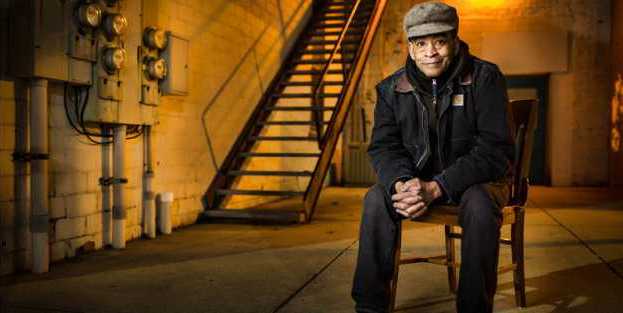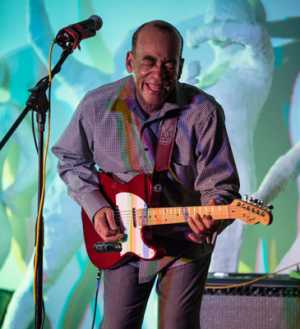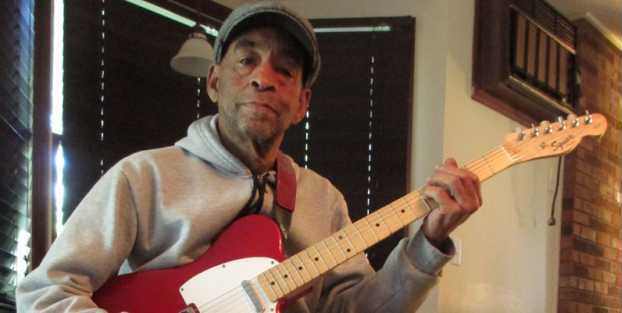| |
Taken from Toledo City Paper (October 07, 2016)
Looking Back by Pushing Forward: Q&A with Skip “Little Axe” McDonald
by Roger LaPointe

Skip “Little Axe” McDonald |
Occasionally, a musician’s name will tickle the back of my brain. Years of reading liner notes and song credits will pay off in catching a legend’s performance, one that pushes boundaries while genuinely entertaining a crowd.

By Giles Cooper
Skip “Little Axe” McDonald Live at Grounds for Thought, in Bowling Green, OH. |
With hundreds of recording sessions under his belt and 57 years of performing, Skip “Little Axe” McDonald should be getting recognition. For the album collectors and trivia guys, this interview is for you. Skip’s guitar licks and rhythm work graced the recording halls of Sugar Hill Records and ran the classic east coast Chitlin’ Circuit from Halifax down to Atlanta. I was fortunate enough to hear him twice this year, at the 2016 Black Swamp Arts Festival and during his live limited edition Little Axe: One Man-One Night performance, recorded at Grounds For Thought.
You have a lot of fans out there, who may not realize that they are fans. Can you give me your name?
Well, my stage name is Skip “Little Axe” McDonald, but my real name is Bernard Alexander.
You’re a blues guitarist, but please give me a little history of names you’ve worked with.
Sure thing. I was with Sugar Hill from ’79-82, as the house band guitar player. We had a steady flow of people going through there, but I worked with Doug Wimbish, Eddie Fletcher, Grand Master Flash, the Treacherous Three and a whole lot more. More recently, I’ve worked with Adrian Sherwood and Keith LeBlanc.
The blues has been criticized for being backward looking, but that list of names is highly progressive.
All music is one music. It’s only 13 notes. I don’t let categorization define my music, but you can’t separate the blues from rock, jazz, funk, rap… and different interpretations. Trying to separate it is crazy. It’s another front man that brings you into the fold. It’s like popular culture. The young and energetic push the music through. What you hear is my years of learning. I’m as much a product of what I’ve listened to as an earlier musician is a product of what he’s listened to. It’s about merging, like my life history. I’ve been through Albert King, B.B. King, Freddie King, Jimi Hendrix, Rap and beyond Hendrix. The music you let in, is the music you let out.
From blues to rap, how did that come about?
What else? I’m a career musician. I had to stay employed. I had my first gig at 10 years old with a gospel show, but I did R&B, jazz… whatever was needed to entertain the people. I left Dayton for the road when I was 18, just some friends in a couple beat-up old cars. We played every night, sometimes four to six hours, maybe twice on Sunday with recording thrown in. We had to have a big repertoire of songs to play that much. Playing seven nights a week gave us a level of musicianship that’s hard to find today. Everyone did it like that. That first road show started in Youngstown, then Montreal. It was the Chitlin’ Circuit, the East Coast leg from Halifax to Atlanta. Places like the Cotton Club and Golden Nugget. It was intensive playing. That culture of a scene doesn’t really exist today. Today, maybe you play an hour, or just 30 minutes. Today is different. The more you play, the better you get.

By Roger LaPointe
Skip “Little Axe” McDonald has built the blues guitar into the fabric of our cultural soundscape for 57 years. |
What were some of your influences?
I went through Jimi Hendrix and Stevie Ray, but it was really my earliest influence, my dad. He played Blind Boy Fuller and whatever my dad had on in the house at the time I was growing up, even before I was born. We had a fun house with a lot going on and he played piano and guitar, not professionally, just for fun.
I’ve looked up your name and there’s a lot out there, would you expand on that, including your solo work?
Well, there are hundreds of recordings. I’ve no idea how many. Sometimes I got credit and sometimes… not so much. There were sometimes people going in and out during recording sessions. I think you can find a lot of it listed different places on the internet, with different names. I’ve had six or seven solo projects, a couple with Sony. I’ve been a producer and writer. This album, we recorded in Bowling Green, was put together with Matt (Donahue) and Walt “Mac” McKeever. It’s a limited edition live thing.
The sound on Little Axe: One Man-One Night is amazing, especially considering that it was live, in a coffee shop/bookstore, especially on the song Tear the System Down…?
As you saw, my live show is just me, with pre-recorded loops. The loop station has drums, bass and keyboard. I control when I bring them in with pedals. My guitar is the real improvisation, within those limits. I started doing that for budget reasons, but it also gives me control of the openings, everything. I had the background vocals done as audience participation, is part of the same thing. The audience is part of the entertainer’s job. You can play for the audience or with the audience. I play with the audience. Sing, clap or otherwise enhance the show. As youth, we always did that. Music is progressive and a learning curve. In the old days we always had audience participation.
Web site: Little-Axe.com
Little Axe: One Man-One Night is available at
Culture Clash Records and Grounds For Thought.
Live version of “Grinning In Your Face,” from the studio album,
Champagne & Grits, can be found on YouTube , which also appears as an
extended version on the live album Little Axe: One Man-One Night.
|
|